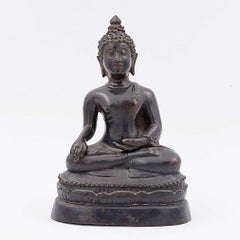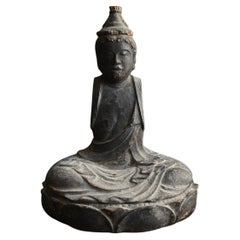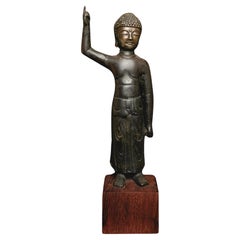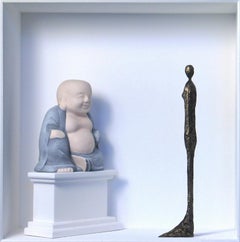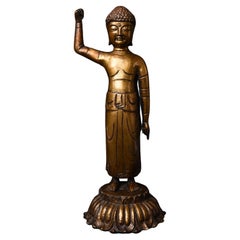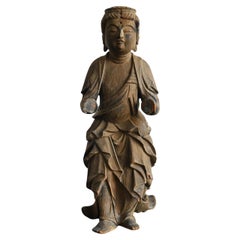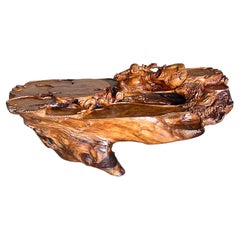Buddha To Buddha
20th Century Asian Sculptures and Carvings
Bronze
Antique 17th Century Japanese Edo Sculptures and Carvings
Cypress
Antique 16th Century Korean Sculptures and Carvings
Iron
21st Century and Contemporary Assemblage Mixed Media
Wood, Mixed Media, Acrylic
Late 20th Century Modern Figurative Prints
Lithograph
Antique 18th Century Korean Antiquities
Bronze
Early 20th Century Austrian Figurative Sculptures
Bronze
Antique 18th Century Japanese Edo Figurative Sculptures
Cypress
20th Century Asian Anglo-Indian Fountains
Teak
Antique 19th Century Tibetan Tibetan Antiquities
Bronze
Antique Mid-19th Century Sri Lankan Sculptures and Carvings
Bronze
Antique 15th Century and Earlier Japanese Other Sculptures and Carvings
Wood
Antique 18th Century Japanese Edo Statues
Stone
Antique 19th Century Indian Serving Bowls
Wood
Early 20th Century Chinese Chinese Export Furniture
Cypress
Antique 15th Century and Earlier Japanese Other Decorative Art
Copper
Antique 17th Century Thai Folk Art Metalwork
Bronze
1980s Other Art Style Figurative Paintings
Mixed Media
1990s Abstract Abstract Prints
Lithograph, Offset
Antique Early 17th Century Tibetan Metalwork
2010s Contemporary Landscape Photography
Silver
Mid-20th Century American Mid-Century Modern Table Lamps
Ceramic
Antique 15th Century and Earlier Chinese Antiquities
Limestone
Mid-20th Century American Mid-Century Modern Table Lamps
Plaster
Early 20th Century Japanese Taisho Sculptures and Carvings
Stone
Early 20th Century Thai Religious Items
Bronze
Mid-20th Century Japanese Showa Paintings and Screens
Paper
Early 20th Century Japanese Taisho Sculptures and Carvings
Bronze
Antique 18th Century Mongolian Antiquities
Copper
Antique 19th Century Japanese Drawings
Paper
Early 20th Century Japanese Taisho Sculptures and Carvings
Bronze
20th Century Pendant Necklaces
Onyx, Yellow Gold
Antique 15th Century and Earlier Chinese Antiquities
Limestone, Steel
Mid-20th Century Japanese Showa Paintings and Screens
Paper
Antique Mid-19th Century Chinese Qing Sculptures and Carvings
Hardwood
Late 20th Century Other Art Style Figurative Paintings
Mixed Media
Antique 1890s Tibetan Tibetan Antiquities
Bronze
20th Century Paintings
Canvas
Antique 18th Century Japanese Edo Sculptures and Carvings
Stone
Mid-20th Century Figurative Sculptures
Milk Glass
Antique 15th Century and Earlier Chinese Ming Sculptures and Carvings
Stucco
Antique 19th Century Tibetan Tibetan Antiquities
Bronze
Antique 19th Century Thai Sculptures and Carvings
Bronze
Late 20th Century Asian Ceramics
Porcelain
Early 20th Century Thai Religious Items
Bronze
Antique 17th Century Japanese Edo Figurative Sculptures
Cypress
Vintage 1920s American Table Lamps
Late 20th Century Other Art Style More Art
Mixed Media
Antique Late 18th Century Indian Prints
Canvas, Silk
Buddha To Buddha For Sale on 1stDibs
How Much is a Buddha To Buddha?
- How do I identify my Buddha?1 Answer1stDibs ExpertApril 5, 2022To identify your Buddha sculpture, seek the help of a licensed art appraiser knowledgeable in the subject. Identifying Buddhist religious sculptures requires expertise in both the faith and the crafting techniques of various periods in East Asian history. Find a selection of expertly vetted Buddha sculptures on 1stDibs.
- Are Buddha statues Chinese?1 Answer1stDibs ExpertApril 5, 2022China is just one of the many countries that has a tradition of Buddhist sculpture. You can find Buddha statues from many other regions like India and Japan. On 1stDibs, you’ll find a collection of antique and modern Buddha statues from some of the world’s top sellers.
- 1stDibs ExpertApril 5, 2022What a Chinese Buddha represents depends on its pose and other characteristics. For example, the Budai or laughing Buddha is generally a symbol of happiness and good fortune that comes from working to achieve enlightenment. Find a range of Buddhist art on 1stDibs.
- Is Buddha Chinese or Japanese?2 Answers1stDibs ExpertFebruary 22, 2021The Buddha's origins are Chinese, but Buddhism has since made its way to Japan and, later, Korea.
 Lotus GalleryMarch 17, 2021Gautama Buddha was an Indian prince born in modern day Nepal. The first images of the Buddha were created almost simultaneously in Mathura, India, and the Greco-Buddhist kingdom of Gandhara (modern day Pakistan and Afghanistan). From there, images fo the Buddha spread out along trade routes into East and Southeast Asia.
Lotus GalleryMarch 17, 2021Gautama Buddha was an Indian prince born in modern day Nepal. The first images of the Buddha were created almost simultaneously in Mathura, India, and the Greco-Buddhist kingdom of Gandhara (modern day Pakistan and Afghanistan). From there, images fo the Buddha spread out along trade routes into East and Southeast Asia. - 1stDibs ExpertApril 5, 2022The purpose of a Buddha statue relates to worship in the Buddhist faith. It provides a point of focus and reflection for Buddhists when they engage in the meditation required to achieve enlightenment. Find a selection of Buddha statues on 1stDibs.
- What do Buddha statues mean?1 Answer1stDibs ExpertOctober 21, 2020
The most commonly represented Buddha in Chinese Buddhist sculpture is Siddhartha Gautama, also known as Shakyamuni, the Enlightened One, or the Gautama Buddha. He is typically depicted seated upon a lotus throne with his hands in the Bhumisparsha mudra, the Gesture of Witness. This gesture symbolizes the moment that the Buddha claimed the earth as witness to his enlightenment and celebrates his unwavering meditative focus.
- 1stDibs ExpertFebruary 22, 2021There are 28 buddhas in buddhism, with “Buddha” referring to someone who has achieved enlightenment and thus escaped the cycle of death and rebirth.
- Are Buddha heads disrespectful?1 Answer1stDibs ExpertFebruary 22, 2021A Buddha head that isn't attached to a body is considered disrespectful because the idea of decapitating a Buddha is rooted in colonialism and war for Buddhists.
- How do I choose a Buddha statue?1 Answer
 Lotus GallerySeptember 23, 2020
Lotus GallerySeptember 23, 2020A Buddha statue is very personal. You should choose one that speaks to you. If you are a practitioner, you can ask your teacher for assistance as well.
- 1stDibs ExpertApril 5, 2022The Thai Buddha represents the Buddhist religion in Thailand. Sculptures depicting the figure represent the teacher who reached enlightenment and then devoted his life to helping others do the same. You'll find a range of Buddhist art from top sellers around the world on 1stDibs.
- 1stDibs ExpertApril 5, 2022Identifying an antique Buddha statue is a specialized skill, which is best learned by studying the history of the preferred materials and techniques that each region used in producing Buddha statues. The simplest way to verify the age of a Buddha statue is to have an expert evaluate it. On 1stDibs, find a range of professionally authenticated Buddha statues.
 PAGODA REDOctober 21, 2020
PAGODA REDOctober 21, 2020Most ritual figures depict the Buddha in one of three postures: seated, standing, or reclining. Differences in expression, hand gesture (mudras), and accompanying objects can reveal the figure’s place of origin as well as the particular Buddhist teaching depicted. Such Buddha figures are rendered in a variety of media depending on regional art traditions and intended use, ranging from carved stone to cast bronze to lacquered bamboo.
 Lotus GallerySeptember 23, 2020
Lotus GallerySeptember 23, 2020Buddha statues are not inherently lucky or unlucky, though images of the Fat Buddha (Budai or Hotei), have come to be associated with wealth, knowledge, and luck, with people often rubbing the belly or head.
